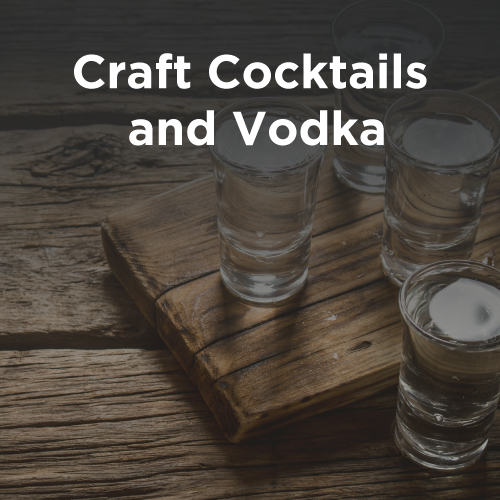
MIXOLOGY TALK PODCAST #185
Alright, friends, today we’re exploring perhaps the most polarizing spirit behind the bar: Vodka. Love it or hate it? Well, if you’re in the “vodka is beneath craft cocktails” camp, today’s guest might just sway you into thinking it’s not so bad after all. H. Joseph Ehrmann is a distinguished bar owner, spirits educator, and industry trailblazer who knows a thing or two about vodka (and everything else spirits and cocktail related). Buckle up and get ready to open your mind because we’re on a journey of vodka exploration!
Click here to Subscribe on your Smartphone and never miss an Episode!
On your iPhone:
Look for the iPhone’s default “Podcasts App”. It may already be there, or you may need to download it. It looks like this:
- In the app, click “Search” in the bottom-right corner and search for “Mixology Talk Podcast“
- Click on the icon under the “Podcasts” section, and in the next screen click the purple “Subscribe” button.
Note:If you prefer, you can also subscribe using the “Stitcher” app, also free & available in the App store.
On your Android Phone:
Download the “Stitcher” app from the Play store by searching for “Stitcher”
- Click on the “Search” icon and search for “Mixology Talk Podcast
- Click “+” to add the show to your Playlist.
Watch Now:
INTERVIEW HIGHLIGHTS:
- 3:00– How vodka fell out of fashion (Check out 10:45 for more on vodka coming back in vogue)
- 14:10– Background on Square One vodka
- 20:35– Basics of vodka (Go to 24:12 for a history of vodka and its ingredients)
- 33:10– Myths of vodka (and distillation at 37:45!)
- 44:30– H.’s advice about vodka for certain cocktails
- 46:17– H.’s promotions and goings-on
MEET H.!
As the 12th proprietor of San Francisco’s second oldest saloon, ELIXIR, H. is recognized as a pioneer in the revitalization of cocktail culture today. He is also an internationally-renowned spirits expert, judge, and educator. Besides his saloon, he has a cocktail event production company (ELIXIR To Go), a beverage industry consultancy (Cocktail Ambassadors), a fresh cocktail mixer company (FreshVictor), and an independent bottler of unique spirits (Kokoro Spirits).
VODKA BASICS: VODKA INGREDIENTS & STYLES AND THE MYTH OF THE FLAVORLESS SPIRIT
There’s the general perception that vodka is odorless, flavorless, and colorless… But that’s not really true! Compare a few brands of vodkas at varying price points, and you’ll see that there is definitely a distinction between the taste and aroma of a quality vodka and a lower-end vodka.
“The difference between a nuanced craft vodka and a high-production industrial vodka is that crafting of changing it a degree or two or trying to retain a certain note on the aroma or on the palette. In a high-production, cheap vodka, you’re not getting that. It’s not made to be that way.” –H. Joseph Ehrmann
But vodka is highly-distilled, meaning it is closer to being flavorless, colorless, and odorless than other spirits. Maybe that’s where the confusion comes from. However, there is still some finessing to be done to create your desired outcome during the distillation process. Let’s delve a little deeper into the background and creation of vodka.
VODKA INGREDIENTS: ARE ALL VODKAS CREATED EQUAL?
An interesting truth about vodka that distinguishes it from other spirits is that you can pretty much make it out of anything (think starchy or sugary plants) . If you can ferment it into alcohol, you can distill it into vodka.
Of course, this can lead to less-than-desirable vodka productions, but it also makes room for a vast amount of creativity. Unlike other spirits, such as whiskey that is made from grain or agave spirits (such as tequila or mezcal) that are distilled only from the agave plant, vodka can vary greatly depending on the raw base ingredient. As H. explains,
“Good vodka does have character. There’s flavor, there’s texture, there’s aroma. And it’s all based on, generally speaking, what the raw ingredient is, the quality of that raw ingredient, and the distillation process.”
So let’s explore some of the more popular, common ingredients of vodka:
- Rye vodka: Wheat and rye are generally regarded as being higher-quality vodka ingredients than other grains, such as corn. H. personally prefers a rye vodka because it has a little spice to it, giving some character to the vodka.
H. recommends sipping a rye vodka in the traditional Russian way rather than mixing it. As he puts it, it’s a “pairing,” not a cocktail. But if you are going to make a vodka martini, for example, still choose a wheat vodka with a bite, something like Kettle One, which holds up well with citrus.
H.’s pick: Chopin rye vodka
- Winter wheat vodka: While a variety of wheats are common in vodka production, winter wheat offers a bready, yeasty taste and smell that provides an overall richer drinking experience. (See, I told you that vodka wasn’t odorless and flavorless!)
H.’s pick: Absolut
- Corn vodka: Corn vodka is the least expensive to produce, making it a popular choice for distillers. However, there are very few organic or non-GMO corn options, so that’s something to consider. Corn is also associated with lower-quality vodkas, although that doesn’t mean they’re all bad! In fact, this is a good option for the gluten-free crowd. Generally speaking, though, corn vodka isn’t typically considered a higher-end product.
H.’s pick: Hetchy
- Potato vodka: This one actually falls into our “myth” category a little bit (more on that soon). In truth, very few vodkas are made from potato because it’s costly to produce enough potato sugar to ferment and distill into vodka; but it’s mistakenly recognized as a common ingredient, so it’s worth mentioning.
When vodka is made from potatoes, the flavor outcome is largely dependent on the type of potatoes used, the time of year they’re grown, and the overall harvest; because of this, the vodka production can vary greatly based on all of these factors. According to H., potato vodka has a creamy viscosity, making this type of vodka all about the mouthfeel. His recommendation: Sip a potato vodka instead of mixing it into a cocktail because of the soft flavor it provides.
Chris’ pick: Karlsson’s
As I mentioned before, though, vodka production is not limited to these ingredients! We’re seeing so much creativity these days, including vodkas made from honey, apples, or even milk whey.
With his long relationship with the brand Square One, H. also sings their praises for pushing the limits of flavored vodka. With options like cucumber, bergamot, and botanical (without juniper, this one walks the line between vodka and gin), Square One offers several quality vodkas that will brighten your drink with a little flavor. It’s definitely worth trying a few different types of vodkas to explore the differences and see what you like best.
And here is H.’s tasting tip: Rinse your mouth with the vodka first (basically like it’s mouthwash), spit it out, and then taste it and see if you actually like it. Look for taste and mouthfeel… And try this with both a $15 bottle and a $40 bottle to see if there’s a big enough difference to you to justify the price difference.
MORE MYTHS ABOUT VODKA
OK, now let’s discuss some of the other major myths that H. and Chris (and all of us, I’m sure) have heard over the years.
MYTH 1: “ALL VODKA IS MADE FROM POTATO.”
As I touched on earlier, this one is total nonsense. According to H., the Polish used potatoes because, when they were being attacked by other countries, their potatoes were underground and couldn’t be burned. Therefore they could still make vodka! But that doesn’t mean the potato is the reigning king of vodka. While some vodka is certainly produced from potatoes, in reality, most vodka is made from various types of grains.
MYTH 2: “YOU WON’T GET A HANGOVER FROM VODKA.”
Alright, I’m not a scientist or distiller, so I highly encourage you to jump to minute 34:50 to learn more about the cuts in distillation and bad alcohols. But the bottom line is that there are bad cuts of alcohol that make it into cheaper spirits, which will cause that nasty hangover… even in vodka.
“The things that give you a hangover are the additional things in a liquid beyond the alcohol, as well as bad alcohols. There’s distillation quality, and where the cuts are made […] you remove the stuff that isn’t good and bottle the stuff that is good.” –H. Joseph Ehrmann
There is only so much “good alcohol” in a production, so maybe only half of what a distillery produces is sellable. But in cheap liquor, a distillery might actually use 75% of what is produced in order to stretch profit margins. So you’re getting bad quality, otherwise unusable alcohol in those cheaper brands. That will give you a major headache the next day.
And what are those “extras” in your spirit? They include outside elements such as charcoal and color from the barreling process, which may be difficult for your body to process. Other hangover factors include the quantity you drink (that should go without saying), dehydration, and sugar content in your cocktails.
MYTH 3: FANCY DISTILLATION = QUALITY
Is a fancy-schmancy distillation and filtration process (diamonds, anyone?) an automatic guarantee for quality? Does it really matter how many times the spirit is distilled? Not according to H.
“Don’t look at any of the marketing hype because marketing is, more so in vodka than in just about any other spirit, the only thing they have to throw at you, and they’re hoping to get those simple hooks. […] Whether you’re using diamonds or charcoal, the whole idea is to capture the things you’re trying to remove. Diamonds may sound fancier, but are they more effective? I doubt it, frankly.” –H. Joseph Ehrmann
Distillation is now mostly being done on column stills, which may have multiple columns for filtration. Again, I am no distillation expert, but H. thoroughly explains how column stills can give you a cleaner, more precisely-honed vodka, beginning at minute 37:45. It’s less about the amount of times the vodka is distilled (or how it’s filtered) and more about the overall process of extracting the right (or wrong, in this case) elements out of the spirit.
THE INS AND OUTS OF VODKA: HOW VODKA FELL OUT OF FASHION AND FOUND POPULARITY AGAIN
Now that we understand the basics, let’s explore how vodka got such a bad rap. Although vodka was wildly popular in the early 2000s (goodness knows I certainly had my fair share of vodka-based cocktails in college), the spirit was totally snubbed by the bartending community around 2005-ish, a view that lasted until recently. I’ve definitely been in bars that flat-out refused to serve vodka; that’s honestly how I started drinking whiskey, so I’m a living testament of the anti-vodka craft cocktail campaign.
HOW CRAFT COCKTAILS SHUNNED VODKA: DEATH TO THE VODKA SODA
H. gives a really detailed explanation of the highs and lows of vodka popularity starting at minute 3:00, so make sure to give his expert descriptions a listen. But we can chalk up the cancelation of vodka to this: The rise of craft cocktails left no room for the simplicity of the ever-popular vodka soda.
For a while, people loved flavored vodkas (guilty), but they were typically sugary and not viewed as being high in quality. Before the craft cocktail movement began, though, there wasn’t a focus on freshness, quality, or unique cocktails; vodka sodas were an easy thing to order or make at home. And, of course, there was the “low calorie” aspect.
But then the focus of the bartending community shifted to flavor and creativity. At first, vodka held on with infusions, but it wasn’t long before craft turned its back on vodka altogether. As H. puts it, vodka drinkers weren’t “easily swayed” from their easy vodka staples, so the craft cocktail movement moved away from vodka entirely because bartenders were appealing to drinkers who appreciated more complex cocktails.
A NEW AGE FOR VODKA COCKTAILS:
Over the last several years, vodka has seen a bit of resurgence, thanks mostly to the rising popularity of the Moscow Mule. And after the height of the craft cocktail, people were ready to re-explore vodka and see how it could fit into more creative cocktails. Plus, as H. notes, there is more of a focus on hospitality now: Instead of telling customers they’re drinking incorrectly, bartenders are more likely to ask, “How would you like to drink?”
With that boost, vodka was primed to be the spirit of the 2020 quarantine, given its simplicity and familiarity. With more people drinking at home rather than at a bar or restaurant, H. has noticed a significant uptick in vodka bottles sales at ELIXIR. Consumers understand vodka and can easily make themselves a simple vodka drink at home without needing any education on it.
And while that may be a turn off for many, the bottom line is that consumers do love their vodka. Which comes down to this for bars: Vodka is a necessity for any bar program. Simply put, it pays the bills, so bars have had to come to terms with the fact that vodka is here to stay.
VODKA FOR EVERYONE: HOW DO YOU USE VODKA IN COCKTAILS?
So now that you’re totally sold on the value of vodka (she says with a lingering bit of cynicism), let us know your favorite vodka cocktail by heading over to our Facebook group! We’re curious how you approach vodka cocktails: Do you make them begrudgingly, or do you embrace them fully? Maybe you see them as a fun challenge to think outside of the box and expand your craft cocktail skills, even if vodka isn’t your forte. Wherever you land in the great vodka debate, we’d love to hear your thoughts and see your vodka creations.
VODKA FOR EVERYONE: HOW DO YOU USE VODKA IN COCKTAILS?
So now that you’re totally sold on the value of vodka (she says with a lingering bit of cynicism), let us know your favorite vodka cocktail by heading over to our Facebook group! We’re curious how you approach vodka cocktails: Do you make them begrudgingly, or do you embrace them fully? Maybe you see them as a fun challenge to think outside of the box and expand your craft cocktail skills, even if vodka isn’t your forte. Wherever you land in the great vodka debate, we’d love to hear your thoughts and see your vodka creations.
Also make sure to check out Fresh Victor if you’re looking for a unique gift for the cocktail-lover in your life. And if you’re going to buy alcohol this holiday season, consider shopping small instead of gravitating toward the bigger brands you’re used to. We know it’s easy to shop big, familiar brands, but we need to look out for each other and support smaller distilleries during these uncertain times. And, of course, head on over to our shop to snag high-quality holiday gifts for all the bartenders and at-home enthusiasts you know (or for yourself)!
Was this Podcast helpful? Click Here to Give us a Rating in iTunes!
Then click “View in iTunes” under the Podcast Image on the left and enter your rating on the “Ratings and Reviews” tab in iTunes.
Thanks!
Your reviews really matter – they help more people find us in iTunes and help us improve this Podcast!




